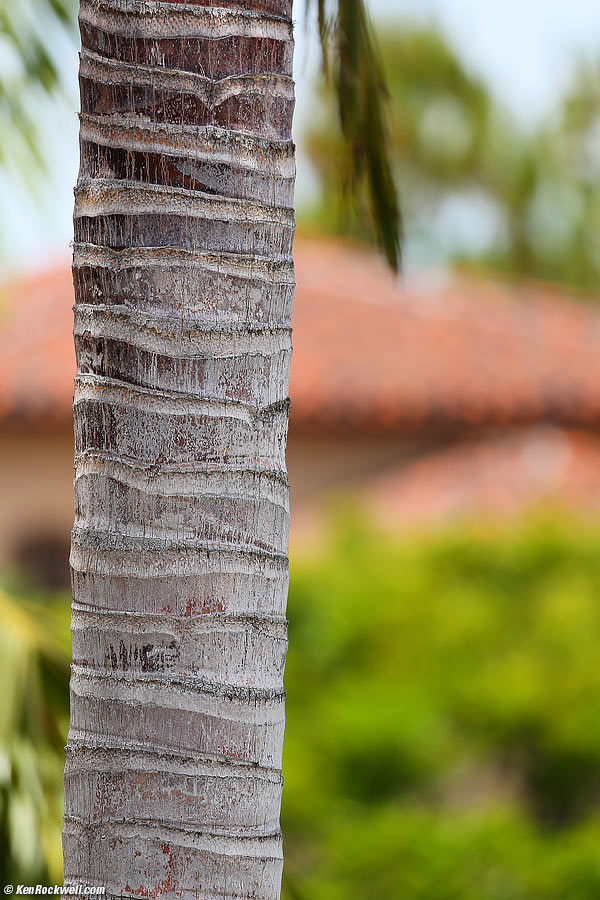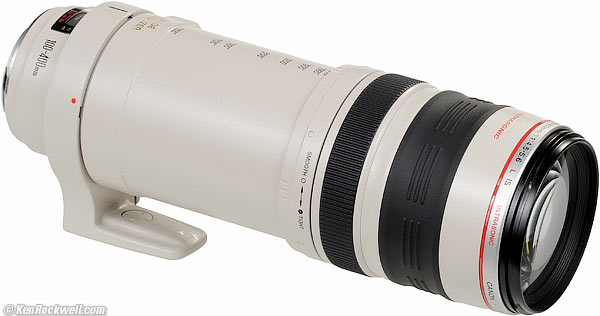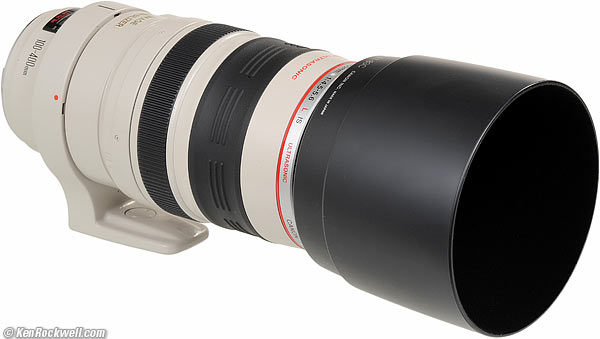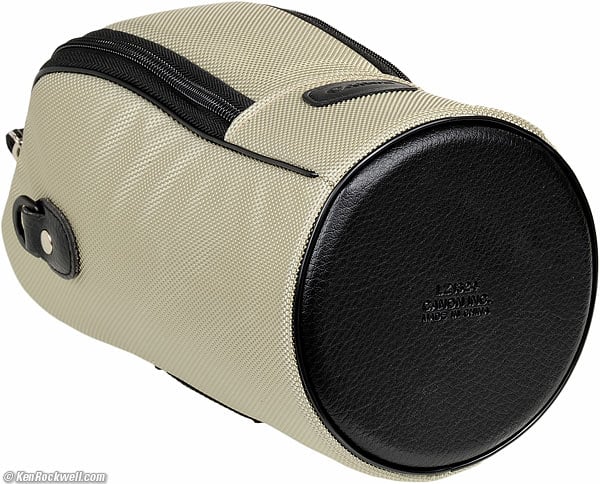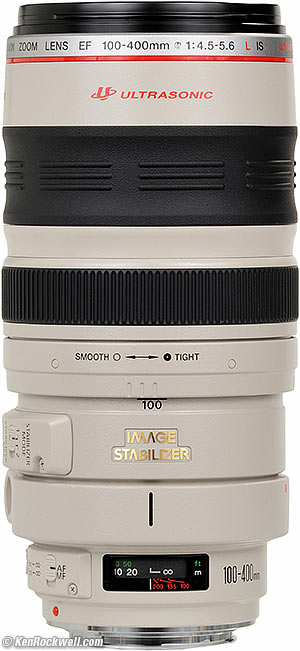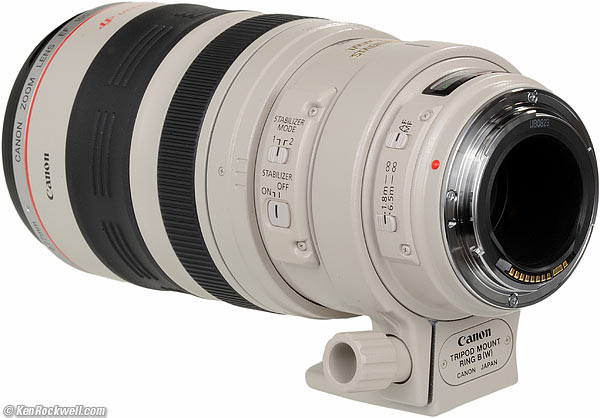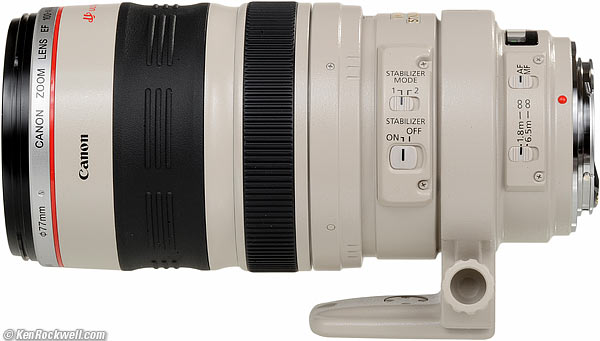Home Donate New Search Gallery Reviews How-To Books Links Workshops About Contact
Canon 100-400mm L IS
Full-Frame EF USM (1998-)
Intro Specs Performance Compared Usage Recommendations More
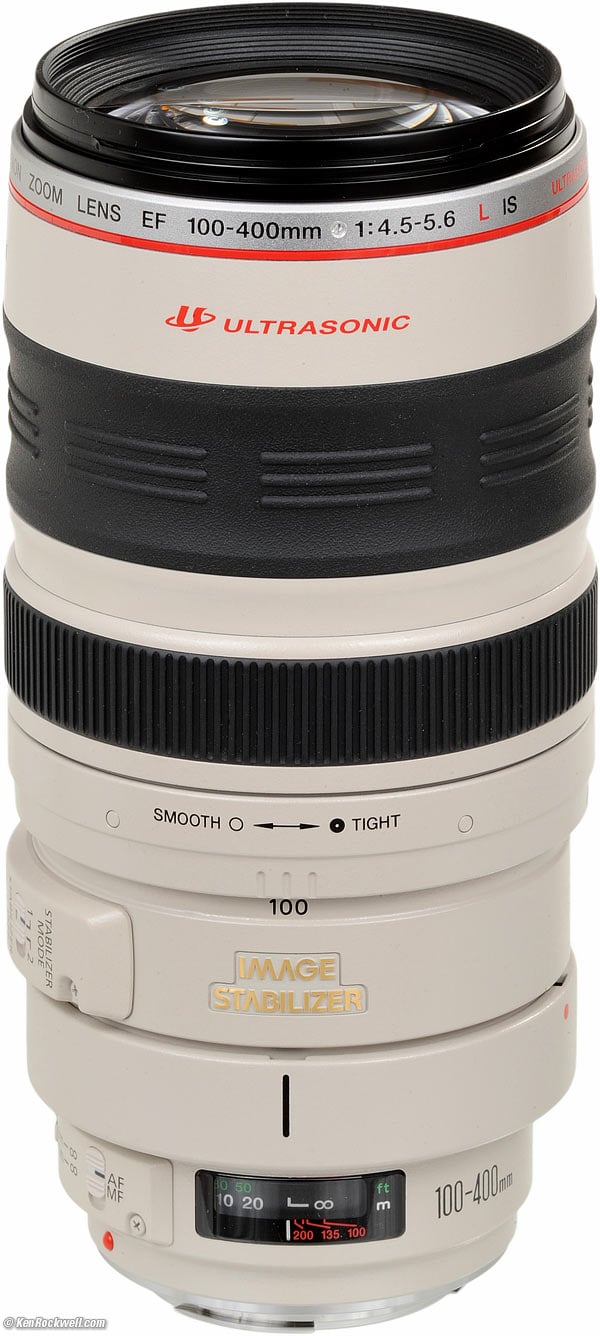
Canon EF 100-400mm f/4.5-5.6 USM (77mm filters, 48.2 oz./1,365g without tripod collar, 6'/1.8m close focus, about $650 used if you know How to Win at eBay, or you can get them new at Amazon.
This free website's biggest source of support is when you use those or these links to approved sources when you get anything, regardless of the country in which you live — but I receive nothing for my efforts if you take the chance of buying elsewhere. Never buy at retail, since unlike milk or DVDs which are sealed, Canon doesn't seal its boxes so you can't tell if it's a used lens or missing accessories.
Thanks! Ken.
August 2022 Canon Reviews Canon Lenses All Reviews
NEW: Canon 100-400mm IS L II. Adds much closer focussing, a zoom ring and better stabilization.
Sample Image Files
(some more also at sample images)
Dildoplant, 29 May 2014. 5D Mark III, 100-400mm at 400mm and f/6.3 at 1/400. Camera-original file.
Palm Trunk, 29 May 2014. 5D Mark III, 100-400mm at 400mm and f/5.6 at 1/400, Perfectly Clear. Full-Resolution file.
Introduction top
Intro Specs Performance Compared
The Canon 100-400mm IS L is a very high performance ultra-telephoto zoom. It's also a huge bargain because it's been in Canon's catalog for a while, so it's an incredible deal today for an ultrasharp super long zoom.
The 100-400 is a fully professional L lens; I have a couple of friends who earn their livings photographing wildlife with it. This 100-400mm is the perfect safari and portable wildlife lens, far superior to using a 70-200 and a teleconverter
Its image stabilization lets us shoot even at 400mm hand-held at low ISOs in reasonable light.
It's a tough all-metal, fast-focusing super zoom that's the same size and weight as the 70-200mm f/2.8 lenses.
It's ultra sharp and has very little distortion, and with nearly no Focus Breathing, ideal for digital cinema shooting.
It has been an extremely popular lens ever since it was introduced in 1998. Nikon has nothing close. Nikon's old 80-400mm VR was a clunky lens that couldn't focus very close and had very slow and clumsy autofocus, and today's Nikon 80-400 VR II is a mostly plastic consumer lens - and costs nearly double what this thoroughly professional metal Canon lens costs!
Like most Canon pro lenses, the 100-400mm's autofocus is fast and silent, and you may grab the focus ring at any time for instant manual override.
It's a push-pull zoom. Since this lens gets so much longer as zoomed, push-pull is smoother, faster and more precise than trying to turn a zoom ring to move all this glass this far. It has an easily adjustable drag control to let you set your preference for friction.
Canon EF 100-400mm IS USM zoomed to 400mm. bigger.
Specifications top
Intro Specs Performance Compared Usage Recommendations More
Name
Canon calls this the Canon Zoom Lens EF 100-400mm f/4.5-5.6 L IS ULTRASONIC.
EF: Electronic Focus. All modern Canon lenses focus with a motor in the lens.
L: Expensive as L.
IS: Image Stabilization so we don't need a tripod.
ULTRASONIC (USM): UltraSonic focus Motor. The focus motor is silent.
Optics
17 elements in 14 groups.
One fluorite element.
One Super UD element.
Push-pull zoom; gets longer as zoomed to 400mm.
Internal focus, nothing moves externally as focussed.
Diaphragm
Front, Canon 100-400 USM at 400mmm (EF diaphragm not visible).
8 straight blades.
Stops down to f/32-40.
Close Focus
6 feet (1.8 m), marked.
Maximum Reproduction Ratio
1:5 (0.2x).
Minimum Subject Field
4.7 x 7.1 inches.
120 x 180 mm.
Focal Length
100-400mm.
On APS-C cameras, it gives angles of view similar to what an 160-650mm lens would give on a 35mm or full-frame camera. See also Crop Factor.
Angle of View
On full-frame:
24º - 6.1º diagonal.
20º - 5.1º horizontal.
14º - 3.5º vertical.
Maximum Aperture
f/4.5-5.6.
Hood
Canon 100-400 with hood. bigger.
The plastic bayonet ET-83C hood is included.
Case
Canon includes a zippered and velcro closing padded nylon LZ1324 case.
It also fits the 35-350mm f/3.5-5.6L USM, 70-200mm f/2.8L IS USM, 70-200mm f/2.8L USM, and 180mm f/3.5L Macro.
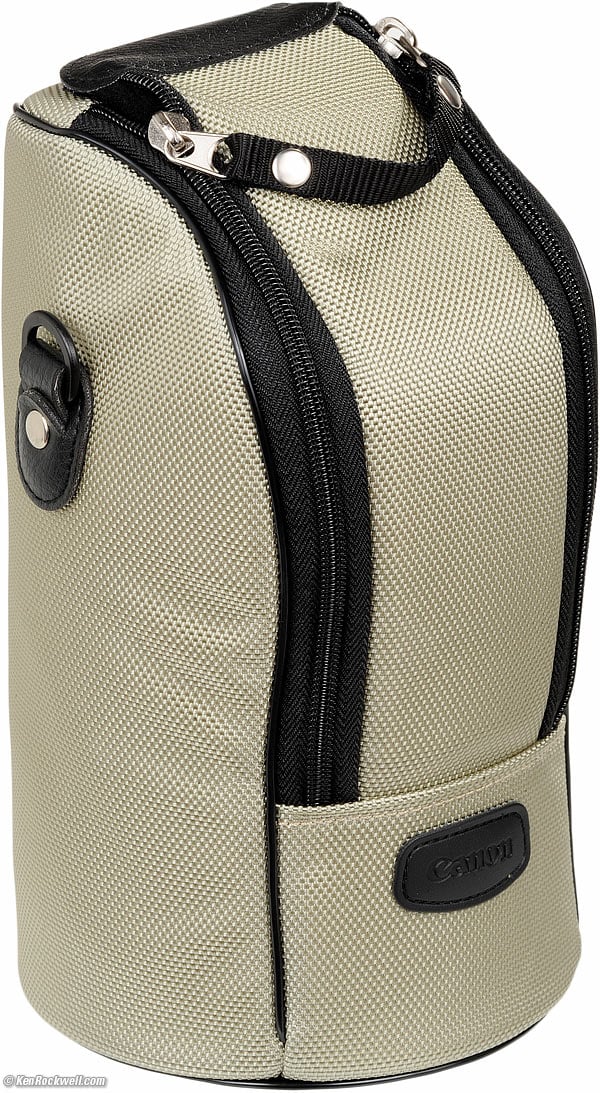
Included LZ1324 case.
Zipper and Velcro closure of LZ1324 case. bigger.
This is a real case. You can use the double-handled zipper for solid closing, and once open, there's velcro on the top for shot-to-shot open and closing. Bravo!
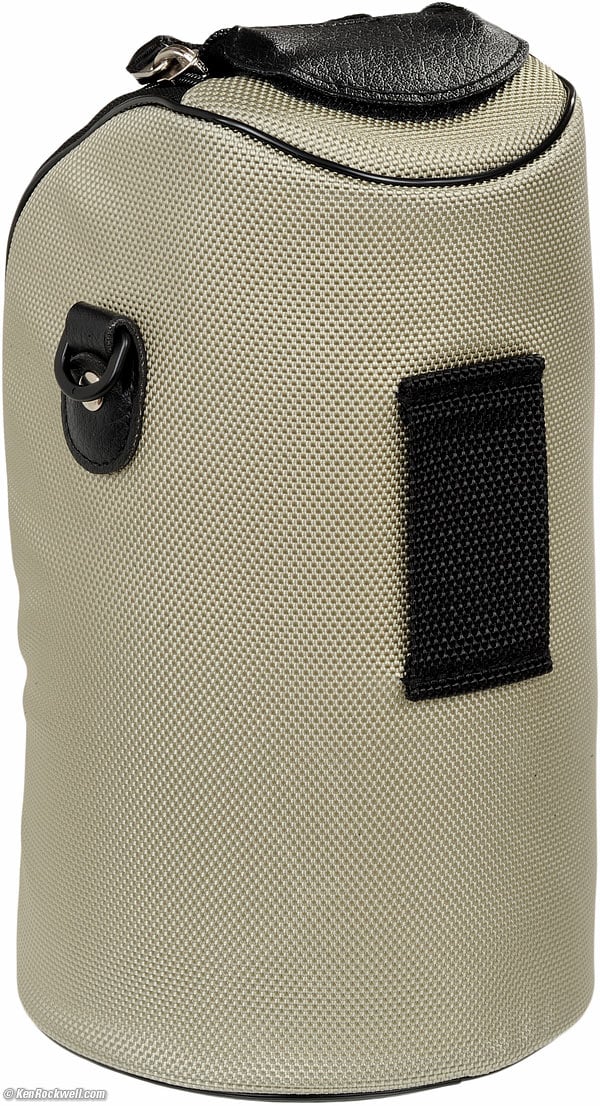
Back of LZ1324 case.
Bottom of LZ1324 case. bigger.
Size
3.6" (92mm) diameter x 7.4" (189mm) set to 100mm.
Gets much longer when set to 400mm.
Weight
52.307 oz. (1,482.8g) with collar.
48.160 oz. (1,365.3g), collar removed.
4.150 oz. (117.65g), collar only.
Rated 48.7 oz./1,380g.
Announced
November 1998.
Canon Item Code
2577A002.
Includes
Lens.
Caps.
Metal removable tripod collar.
August 2022
About $650 used if you know How to Win at eBay.
September 2017
About $750 used if you know How to Win at eBay.
May-November 2014
$1,500 after rebate, new.
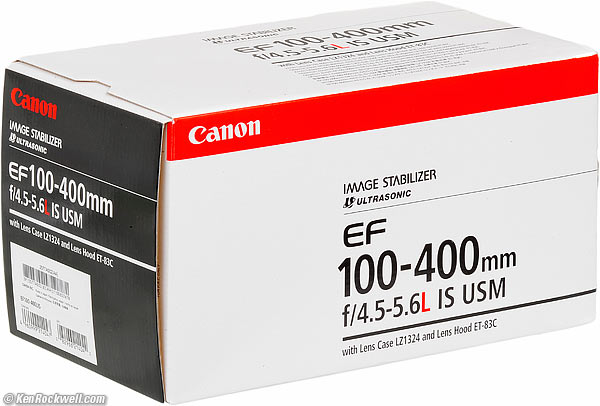
Box, Canon 100-400mm.
Performance top
Intro Specs Performance Compared Usage Recommendations More
Overall Autofocus Bokeh Breathing Color
Distortion Ergonomics Falloff Filters Ghosts
Image Stabilization Lateral Color Fringes Macro
Max & Min Apertures Mechanics Sharpness Sunstars
Overall performance top
The Canon 100-400mm USM is optically and mechanically fantastic. When you actually get yours, you'll be hugely impressed at what a deal you've gotten on this lens today.
Focus performance top
AF is fast, silent and accurate.
AF Speed
Autofocus is almost instantaneous, as well as nearly silent.
Auto/Manual Switching
Just grab the focus ring anytime for instant manual-focus override.
To lock it into manual mode, move the switch on the lens.
Bokeh performance top
Bokeh, the quality of out-of-focus areas as opposed to the degree of defocus, is pretty good, especially at the 400mm end.
Focal length is far more important than aperture, so try your head shots at 400mm and you'll be quite pleasantly surprised compared to what you get on a 70-200 at 200mm and f/2.8.
Color Rendition performance top
The color balance of this 100-400 seems the same as my other Canon EF lenses.
Distortion performance top
The Canon 100-400 USM has minor pincushion distortion throughout most of its range, and no distortion at its 100mm setting.
For more critical use, use these values in Photoshop's Lens Distortion tool to remove the distortion. These aren't facts or specifications, they are the results of my research that requires hours of photography and calculations on the resulting data.
On Full-frame and 35mm |
at 10' (3m) |
at infinity
|
100mm |
0.0 |
0.0 |
135mm |
-1.0 |
-0.5 |
200mm |
-1.5 |
-1.5 |
300mm |
-2.0 |
-1.8 |
400mm |
-2.0 |
-2.0 |
© 2014 KenRockwell.com. All rights reserved.
Ergonomics performance top
Canon EF 100-400mm USM at 100mm. bigger.
Ergonomics are great.
Grab the front and move it back and forth to zoom.
The biggest black front rubber ring is where you hold it to zoom.
The thinner black ribbed rubber ring is the manual focus ring. Move it any time with a fingertip for instant manual focus override.
The focus and IS switches all fall under my left thumb so I can locate them by feel.
Canon EF 100-400mm USM at 400mm. bigger.
Falloff (darkened corners) performance top
Falloff is negligible, even without a profile.
In a DSLR with an automatic correction profile like the 6D, 5D Mk III and 1DX, the falloff is completely invisible.
I've greatly exaggerated the falloff by shooting a flat gray target and presenting it against a gray background:
Canon 100-400mm USM falloff on Full-Frame Uncorrected
© 2014 KenRockwell.com. All rights reserved.
Corrected with profile in 5D Mk III
© 2014 KenRockwell.com. All rights reserved. |
Filters, Use with performance top
There's no problem with vignetting even with a stack of several filters.
There's no need for thin filters; regular thick and rotating filters work great.
Focus Breathing performance top
Focus breathing (the image changing size as focused) is mostly of interest to cinematographers who don't want the image changing size ("breathing") as the lens is focused among different subjects.
There is only the slightest bit of breathing at the 100mm end, and I cant see any at all at the 400mm end. If you can see any, the image gets slightly smaller as focussed more closely.
Ghosts performance top
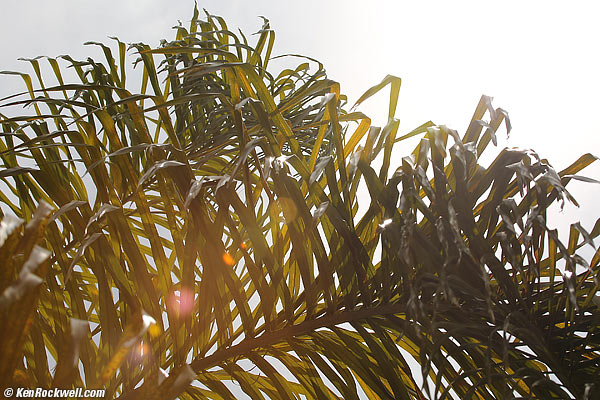
Shot directly into the noontime sun at 100mm at f/11, with a UV filter over the lens!
There's no problem with flare or ghosts.
Even shot directly into the sun and putting a tree in the bottom of the shot to highlight any ghosts that might materialize, there's nothing significant when you realize that the direct unshielded disc of the sun is in the top of the image, and I couldn't look through their finder because it was so literally blinding.
In actual use, there will be none.
This is excellent performance, and if you really push it, you can get just a little bit of ghosting, which will enhance your images.
Image Stabilization performance top
Image Stabilization works, but not as ridiculously well as it does on the newest lenses.
At 400mm, you'll want to shoot at 1/60 or faster. I rarely get great shots at slower than 1/60 hand-held at 400mm. I can't get sharp shots at 1/15 or 1/8 as I can with some newer model (and shorter) lenses.
Of course I can get great shots at even slower speeds at the shorter zoom settings; it's just that one needs to be the most careful at 400mm.
Lateral Color Fringes performance top
On my 5D Mark III there are no color fringes, with or without with a lens profile. This is fantastic!
Macro performance top
Macro gets sort of close. Here's what you get on full-frame at six feet (1.8m):
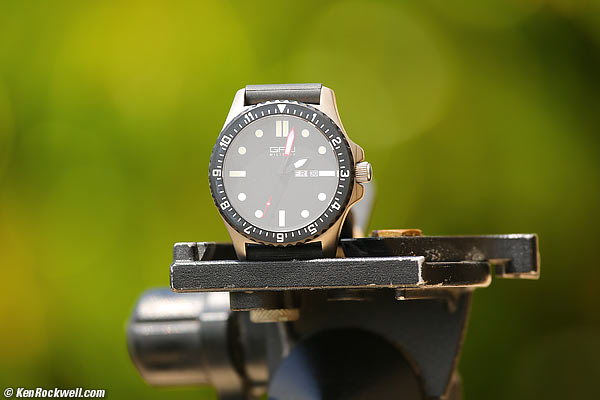
At close-focus distance at 400mm at f/6.3.
Maximum and Minimum Apertures top
Maximum Aperture |
Minimum Aperture |
|
100mm |
f/4.5 |
f/32 |
135mm |
f/5 |
f/32 |
200mm |
f/5.0 |
f/36 |
300mm |
f/5.6 |
f/40 |
400mm |
f/5.6 |
f/40 |
Mechanics performance top
Rear, Canon 100-400 USM. enlarge.
The Canon 100-400 USM is mostly metal. It's a real pro lens.
Filter Threads
Plastic.
Hood Mount
Plastic.
Identity Ring
Painted on front metal ring near the front.
Front Barrel (between identity ring and zoom ring)
Plastic.
Zoom Ring
Rubber-covered plastic.
Focus Ring
Metal, rubber covered.
Mid Barrel (section with focal length scale)
Metal.
Switches
Plastic.
Tripod Collar
Metal.
Removable.
Rear Barrel (section with focus window)
Metal.
Moisture seal at mount
No.
Mount
Chromed metal.
Markings
Paint.
Serial Number
Engraved into metal lens barrel near mount.
Filled with black paint.
Date Code
Stamped on rear light shield (inside mount).
See Canon Date Codes.
Noises When Shaken
Very mild clunking.
Made in
Made in Japan.
Sharpness performance top
Image sharpness depends more on you than your lens, and lens sharpness doesn't mean much to good photographers. It's the least skilled hobbyists who waste the most time blaming fuzzy pictures on their lenses, while real shooters know that few photos ever use all the sharpness of which their lenses are capable due to subject motion and the fact that real subjects are rarely perfectly flat.
This Canon 100-400 is extremely sharp throughout all of the full frame image at every setting.
It's super-sharp wide open, and diffraction will dull the image at the smallest apertures.
Canon's specified MTF curves:
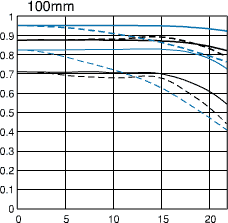 |
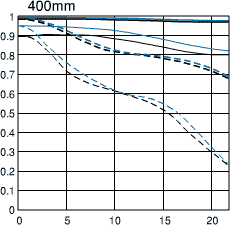 |
MTF at 100mm |
MTF at 400mm |
Sunstars performance top
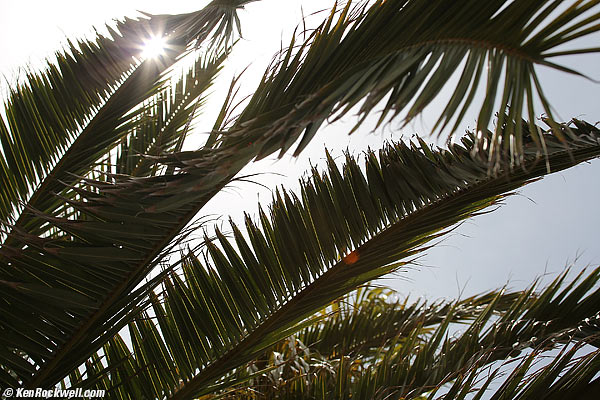
Canon 100-400mm sunstars at 100mm at f/10.
With its octagonal diaphragm, this Canon 100-400mm L IS makes 8-pointed sunstars on brilliant points of light.
I'm not a fan of 8 pointed-stars (I prefer 14 and love 18 pointed stars), but I'll take these 8-pointed stars over no stars any day.
Compared top
Intro Specs Performance Compared Usage Recommendations More
Versus Canon
The new 100-400mm II focuses faster and much closer, and has a zoom ring instead of a push-pull zoom. The new lens' IS system works much, much better for sharper hand-held results at 400mm.
Canon makes a crazy 28-300mm lens that is very heavy and not all that great optically.
Forget using a teleconverter with a 70-200/2.8. It will be softer and much clumsier, and you'll keep having to swap the converter in and out to zoom over the same range that the 100-400 covers all by itself.
Versus Nikon
Nikon has nothing close.
Nikon's old 80-400mm VR was a clunky lens that couldn't focus very close and had very slow and clumsy autofocus.
Today's Nikon 80-400 VR II is a mostly plastic consumer lens - and costs nearly double what this thoroughly professional metal Canon lens costs!
Nikon makes a popular 200-400mm f/4 VR, however it costs more than four times what this canon lens does, weighs more than double, can't focus as close, and only covers half the zoom range of this 100-400mm Canon.
Versus Tamron and Sigma
The third party lenses are disposable. While the Sigma has decent optics, neither is built to last.
Usage top
Intro Specs Performance Compared Usage Recommendations More
Switches, Canon 100-400 USM. enlarge.
Image Stabilization
I'd leave it on all the time, except for time exposures on a tripod.
MODE 1 is normal.
MODE 2 is for panning.
Focus Ranges
Use the 1.5m - ∞ setting, unless you're shooting far-away objects and are having a problem with the lens getting confused and trying to focus on close objects. If you have this problem, the 6.5m - ∞ setting will prevent the lens from trying to focus any closer than 20 feet.
Filters
I'd leave either a 77mm Canon UV filter or a 77mm Hoya Alpha MC UV on the lens at all times.
If you want the best possible protective filter, the 77mm Hoya HD2 Protector is ultra multicoated, repels dirt and fingerprints and made of shatter resistant glass.
If I was working in nasty, dirty areas and don't want to spring for the HD2 filter, I'd use an uncoated 77mm Tiffen UV filter instead. Uncoated filters are much easier to clean, but more prone to ghosting.
I would leave the hood at home.
For color slides like Velvia 50, I use a 77mm Hoya HMC 81A outdoors.
For B&W film outdoors, I'd use a 77mm Hoya HMC Yellow K2 or 77mm Hoya HMC Orange.
Recommendations top
Intro Specs Performance Compared Usage Recommendations More
This is a great professional lens at what today is a steal of a price.
If you think you want one, get it. You'll LOVE it! I have a friend who's owned one of these for years leading safaris in Africa, and we have his images on our walls. They look fantastic! You could pay a lot more and get a lot less for long lenses.
If you find my work here helpful, my biggest source of support for this free website is when you use this link directly to them at Adorama or to them at Amazon when you get yours, or any of these links when you get anything, regardless of the country in which you live. It helps me keep adding to this free website when you get your things through these links to approved sources — but I receive nothing for these efforts if you take the chance of buying elsewhere.
Thanks for your support!
Ken.
More Information top
Intro Specs Performance Compared Usage Recommendations More
The Canon Museum's 100-400mm page
Help me help you top
I support my growing family through this website, as crazy as it might seem.
The biggest help is when you use any of these links when you get anything, regardless of the country in which you live. It costs you nothing, and is this site's, and thus my family's, biggest source of support. These places have the best prices and service, which is why I've used them since before this website existed. I recommend them all personally.
If you find this page as helpful as a book you might have had to buy or a workshop you may have had to take, feel free to help me continue helping everyone.
If you've gotten your gear through one of my links or helped otherwise, you're family. It's great people like you who allow me to keep adding to this site full-time. Thanks!
If you haven't helped yet, please do, and consider helping me with a gift of $5.00.
As this page is copyrighted and formally registered, it is unlawful to make copies, especially in the form of printouts for personal use. If you wish to make a printout for personal use, you are granted one-time permission only if you PayPal me $5.00 per printout or part thereof. Thank you!
Thanks for reading!
Mr. & Mrs. Ken Rockwell, Ryan and Katie.
Home Donate New Search Gallery Reviews How-To Books Links Workshops About Contact

